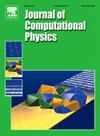A meshfree Galerkin formulation for nonlinear piezoelectric semiconductors in consideration of flexoelectricity
IF 3.8
2区 物理与天体物理
Q2 COMPUTER SCIENCE, INTERDISCIPLINARY APPLICATIONS
引用次数: 0
Abstract
Piezoelectric semiconductors (PSCs) are widely used in a microelectromechanical system, but there is still lack of numerical methods for analyzing the nonlinear multi-field coupling behavior of PSCs in consideration of flexoelectricity. In this study, a meshfree Galerkin formulation is presented for such a nonlinear fourth-order boundary value problem. To satisfy the C1 continuity requirement, the moving least square approximation is employed with a quadratic base. To considering the nonlinear drift-diffusion effect in semiconductors, a nonlinear algorithm with tangent stiffness is proposed, which shows much better convergence than available direct iteration methods with secant stiffness. Further, to simulate electrically isolated PSCs, a Lagrange multiplier method is firstly employed to introduce the electroneutrality condition into the Galerkin weak form. In addition, the consistent integration with nodal smoothed derivatives is used to improve the computational efficiency. Several numerical results validate the proposed formulation and demonstrate the effects of the flexoelectric coefficient, intrinsic length scale parameter and initial carrier concentration.
考虑挠性的非线性压电半导体的无网格伽辽金公式
压电半导体在微机电系统中有着广泛的应用,但考虑柔性电的压电半导体非线性多场耦合特性的数值分析方法尚缺乏。本文给出了一类非线性四阶边值问题的无网格伽辽金公式。为了满足C1连续性要求,采用二次基移动最小二乘逼近。针对半导体中的非线性漂移扩散效应,提出了一种具有正切刚度的非线性迭代算法,该算法的收敛性优于现有的具有正切刚度的直接迭代方法。此外,为了模拟电隔离psc,首先采用拉格朗日乘子方法将电中性条件引入伽辽金弱形式。此外,采用节点光滑导数的一致积分提高了计算效率。几个数值结果验证了所提出的公式,并证明了挠曲电系数、固有长度尺度参数和初始载流子浓度的影响。
本文章由计算机程序翻译,如有差异,请以英文原文为准。
求助全文
约1分钟内获得全文
求助全文
来源期刊

Journal of Computational Physics
物理-计算机:跨学科应用
CiteScore
7.60
自引率
14.60%
发文量
763
审稿时长
5.8 months
期刊介绍:
Journal of Computational Physics thoroughly treats the computational aspects of physical problems, presenting techniques for the numerical solution of mathematical equations arising in all areas of physics. The journal seeks to emphasize methods that cross disciplinary boundaries.
The Journal of Computational Physics also publishes short notes of 4 pages or less (including figures, tables, and references but excluding title pages). Letters to the Editor commenting on articles already published in this Journal will also be considered. Neither notes nor letters should have an abstract.
 求助内容:
求助内容: 应助结果提醒方式:
应助结果提醒方式:


